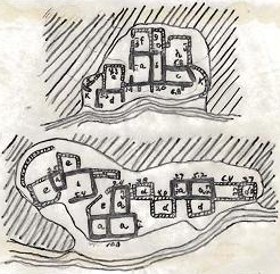|
The following excerpt, written by Adolph Bandelier, describes his sojourn at what is now Tonto National Monument.

NPS Photo The caves are visible at a great distance. We entered a deep canyon where a spring rises. The canyon is narrow; it has no bottom, only a dry arroyo, which is the outlet of the spring. This arroyo is shrouded in verdure, mesquite, thorns of all kinds, large cottonwoods, and walnuts. It is a perfect thicket, and difficult to get through. The slopes rising to the canyon are covered with boulders, and unfit for cultivation. We first visited the lower cave. The slope is exceedingly steep, difficult, on account of the cactus and of the crumbling, slippery, shale cropping out. The height is almost vertical at places. The entire height of the cave is 68 of my heights, or 109 meters, equal to 363 feet. The cave is large, and the eastern declivity [it faces east] is often vertical. The height of the cave is about 20 to 25 feet. Into it the house has been built. It is a perfect house, but small. The walls are of large stones, broken in suit, and laid in clay mixed with gravel, which gives it the appearance of concrete. The proportion of stone to concrete is about equal. I found many metates, three of which were perfect. The manos are small, so as to work in the groove. Many of the roofs are perfect. They are of vigas, above them are either splinters or round ticks of ocotillo, above it reeds, and then two-and-a-half inches of mud. The floors, as far as visible, are black. There is some pottery about, handsomely painted, similar to that of the "cerros" on the Rio Puerco, only much smaller. I found an old sandal, much fragmentary basketwork, rope, twine, and many corncobs. They are of the small variety, and I found one small piece of obsidian. No red-and-black pottery, but some faintly corrugated ware. The majority of the pottery, is dark red and very thick. The position of the pueblo is admirable for security and observation, but I cannot find any tillable lands short of two miles away. As to the timber, it is cedar as to the small cross piece, heavy pine in regard to the central posts, and one of them is hack off even. Others are slightly bifurcated. We then led the horses up to the spring, about a half-mile farther up the canyon, south, and to the foot of the second cave, which is about 400 feet high and steeper than the other. The slope is disintegrated shale, and hardly any cactus or shrubbery. Directly east of it is a very high mountain, with a big cave visible in it. The ruin is larger, but has not such an extensive view, owing to the mountains in front. Both ruins are burnt out. This was done by the Apaches who used to celebrate their dances in the ruins. So Mrs. McIntosh tells me. This ruin is mostly two stories tall. The walls are of the same thickness, 0.30 [meter] on an average. The material is the same. In both cases, the stones are well-broken, but not hewn. In the first ruin I found some arrow shafts made of canes, but not a single arrowhead. [It was very hot.] The lintels of the doors are of wood, several sticks laid across, some of the doors open to the front, but there are little square or quadrilateral holes. The roof is overhanging, or rather projecting, so that unless there is a driving wind from the east, which is said to occur very seldom, rain cannot affect the interior of the cave. Therefore, it is so well-protected and preserved. It is evident, from the manner of construction, that the buildings was accommodated to the sinuosities of the ground. On the stories there were high parapets, and some of the rear rooms were open. There is also an inequality in the height of the various parts. I forgot to take the sections of the larger ruin, but it is so similar to the small one, that it will hardly make any difference at all. From the large ruin, rocks have wasted away, leaving the ascent possible from the north side only. We left the cave at 3 p.m. and rode back. References:Lange,C.H. & Riley, C.L. (1970). The Southwestern Journals of Adolph Bandelier 1883-1884. Albuquerque: The University of New Mexico Press. |
Last updated: October 11, 2020
